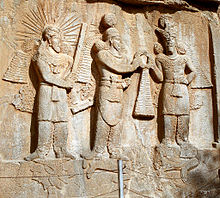

| Part of a series on |
| Zoroastrianism |
|---|
 |
|
|
A barsom /ˈbɑːrsəm/ is a ritual implement used by Zoroastrian priests to solemnize certain sacred ceremonies.
The word barsom derives from the Avestan language baresman (trisyllabic, bar'əs'man), which is in turn a substantive of barez "to grow high."[2] The later form – barsom – first appears in the 9th–12th-century texts of Zoroastrian tradition, and remains in use to the present day.
The baresman is not related to the baresnum, which is a purification ceremony. The baresman should also not be confused with the "mace", the varza (Avestan, MP gurz). The varza is a metal rod, about one centimeter in thickness, often crowned with a bull's head.
It has been suggested that the baresman may have a Zagrosian origin.[3][a]
- ^ Franz Grenet, 2016. "Mithra ii. Iconography in Iran and Central Asia", Encyclopædia Iranica, online edition (accessed 19 May 2016).
- ^ Kanga 1989, p. 825.
- ^ Boyce 1982, pp. 38–39.
© MMXXIII Rich X Search. We shall prevail. All rights reserved. Rich X Search
